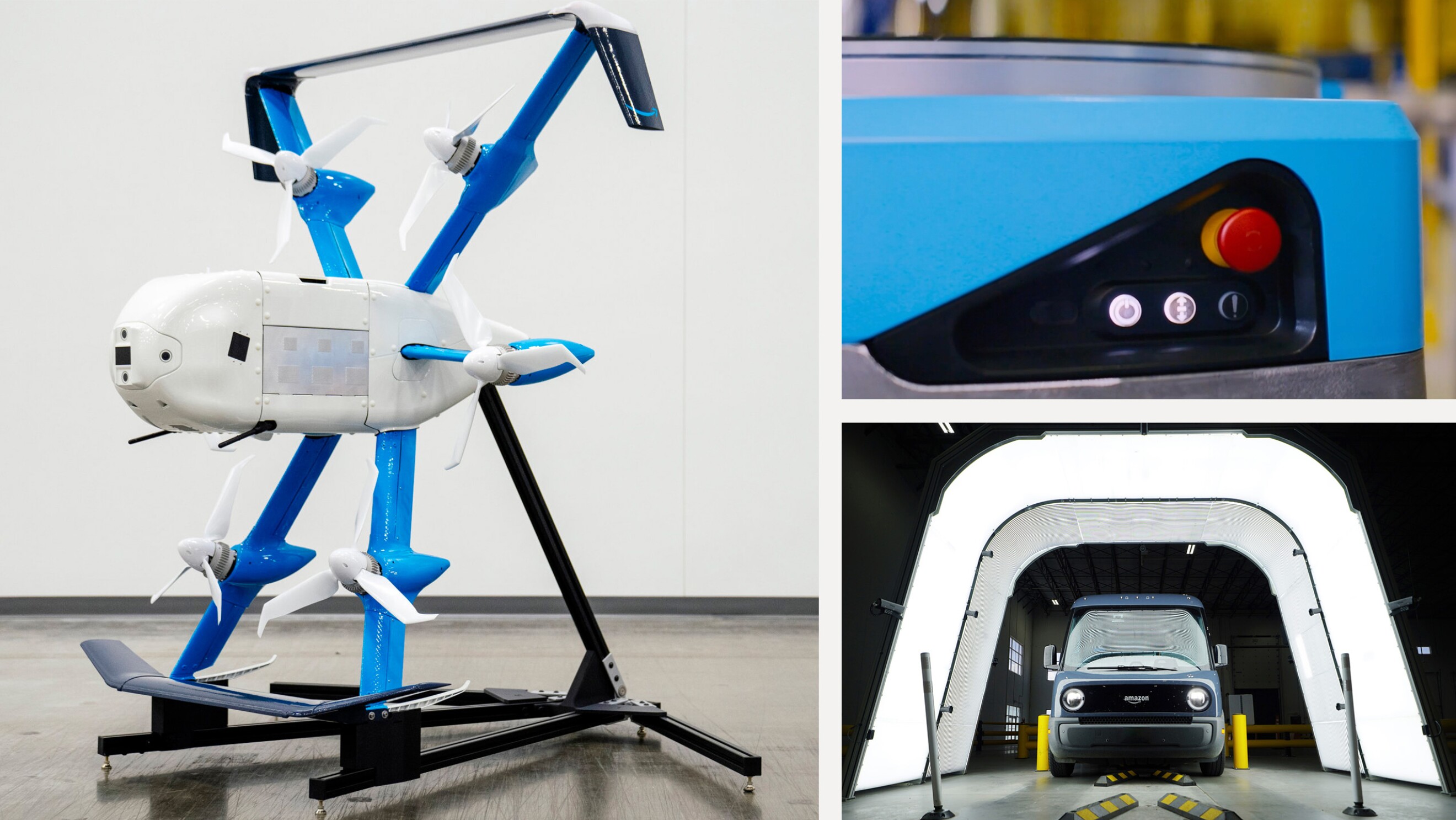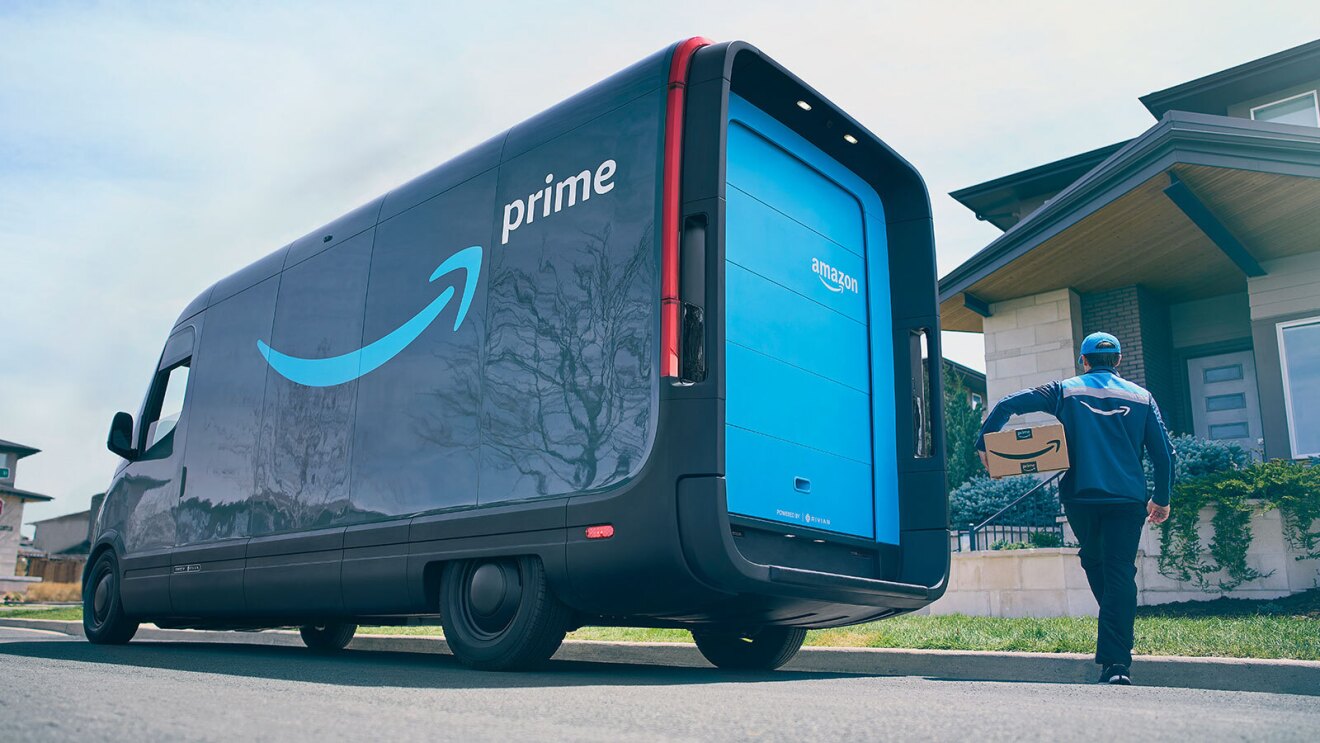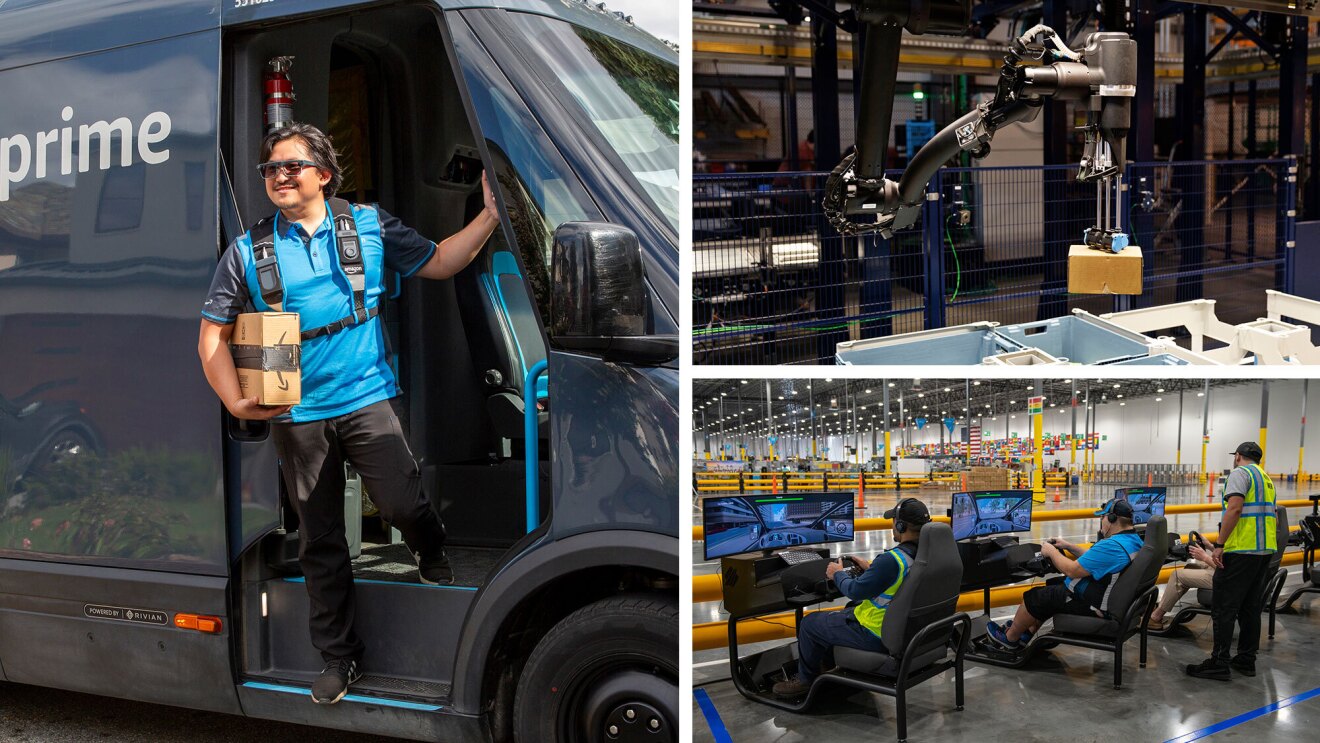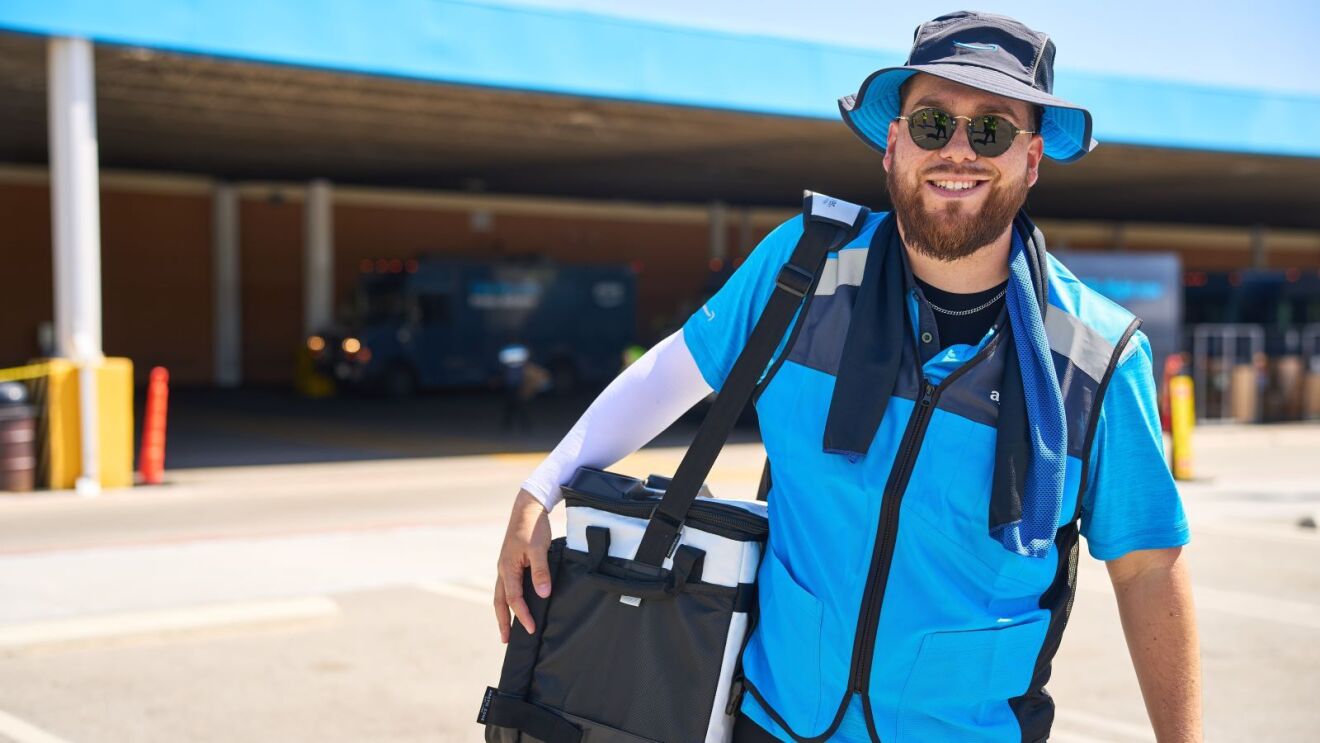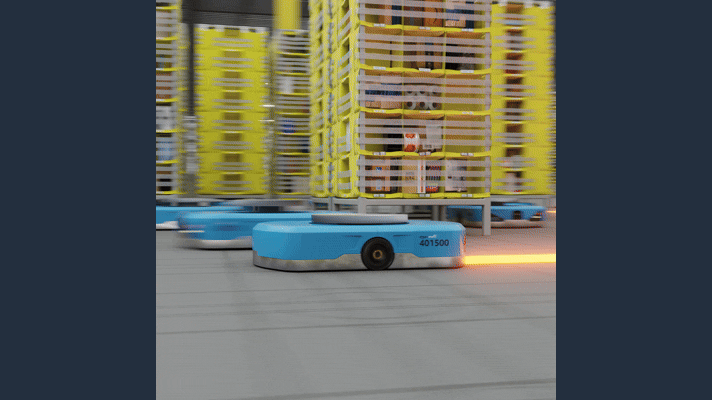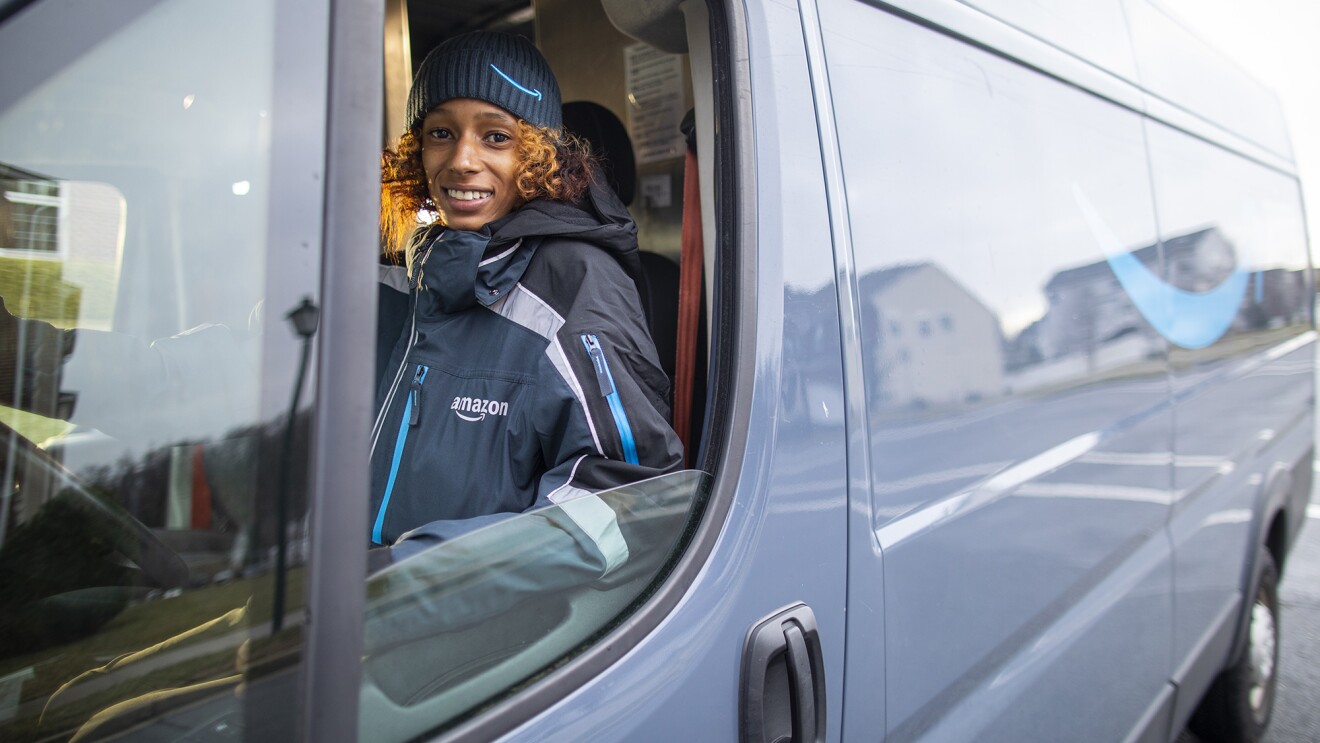Amazon invited reporters from around the world to attend our annual Delivering the Future event at a fulfillment center and innovation lab near Seattle, Washington.
We shared the evolution and journey of our operations network—including how we fulfilled our first customer orders in a garage in 1995 to how we’re using innovative technologies and the latest in artificial intelligence (AI) to make that process better for customers and employees today.
Here are some of the most exciting announcements we’ve made.

1. Reveal of the new MK30 delivery drone
At last year’s Delivering the Future event, we announced the prototype of our latest drone design, the MK30. This year, we revealed a first look at the MK30, which will launch in 2024. The MK30 also has new custom-designed propellers that reduce perceived noise by almost half, is lighter and smaller, and has enhanced capabilities compared to our current MK27 model. It can fly twice as far, allowing us to serve more customers in more locations, and it can operate in more diverse weather conditions, like light rain.

2. Drone deliveries expand in the U.S. and internationally
Prime Air also announced the upcoming launch of drone deliveries in a third U.S. state and international expansion into Italy and the UK by the end of 2024. Moving forward, we’ll be integrating drones into the Amazon delivery network. In the U.S., our new drone delivery operations will operate out of some of our Same-Day Delivery sites. These sites offer a selection of products that are well aligned with things customers want and need fast, and what drones can safely deliver.
3. Amazon Pharmacy and Prime Air team up to deliver medications by drone
We announced a new delivery option for customers with the launch of drone delivery of medications from Amazon Pharmacy. Eligible customers in College Station, Texas, can now get their medications delivered to their homes via drone within 60 minutes of their order with Amazon Pharmacy, and will have access to 500+ common medications.

We’re also making everyday improvements to the Amazon Pharmacy experience through the use of AI, including:
- Using machine learning to estimate insurance copay prices when customers browse medications on Amazon.com.
- Improving efficiency by using entity recognition to convert prescriptions that clinicians send via e-prescribe, fax, or phone to the data format required to operationally process the medications.
- Using computer vision to provide an extra layer of quality assurance for our polychronic customers by double-checking the accuracy of dispensed pill packs.
- Implementing generative AI to enable faster customer service agent support.
4. Amazon teams with MIT and Ipsos to understand how robots can work better for employees
Our employees are the cornerstone of how we deliver great customer experiences, and we are always looking how best to innovate for them and improve our workplace. Advanced technology, like robotics, creates a safer workplace, and these innovations can also help ease employee workloads. We are collaborating with Massachusetts Institute of Technology (MIT) and Ipsos to further assess how automation is impacting the work our employees do and how we can support their careers as new technologies emerge.

5. New robotic systems will help employees deliver for customers
We announced some of our latest robotics innovations that reduce repetitive motions and make fulfilling customer orders easier for our employees. Thanks to new technologies, like Sequoia, we will be able to identify and store inventory we receive at our sites up to 75% faster than we can today, to the benefit of both sellers and customers.
6. Using computer vision and AI to improve fleet maintenance
When it comes to using technology for safety, we think about our fulfillment centers and beyond. We unveiled Automated Vehicle Inspection (AVI), a new AI-powered technology that helps Delivery Service Partners (DSPs) maintain their fleet and saves drivers time by automating part of the post-trip inspection process. Launched in partnership with tech startup UVeye, AVI will be rolled out at Amazon delivery stations in Canada, Germany, the UK, and the U.S.

7. Expanding our disaster capabilities to more quickly help communities
We mobilize the same logistics infrastructure, vast inventory, and technology that we use to serve our customers to help communities impacted by natural disasters and humanitarian crises. That’s why we’ve launched Disaster Relief Hubs around the world. These hubs are dedicated spaces within Amazon’s global logistics network to store and quickly pack and deliver items that are most needed following natural disasters and other emergencies. This fall, we announced two new sites to continue expanding Amazon’s global disaster relief network, so we can be closer to where emergencies take place:
- New Disaster Relief Hub in Melbourne, Australia. This brings us to a total of six relief hubs in the country, where Amazon has already responded to wildfires and flooding.
- New Disaster Relief Hub in Japan. This site opened in September, and it’s the second of these facilities in the country.
The disaster capabilities we’re launching are made possible thanks to our global logistics and technology expertise, enabling us to help communities, relief agencies, and nonprofits when they need it most. Through Amazon Web Services (AWS), we bring cloud technology to hard-hit areas to support with efforts such as mapping, establishing connectivity, and quickly increasing capacity for emergency call centers. We also bring the power of Amazon’s voice AI technology to help communities prepare for and respond to disasters. We worked with the Red Cross to develop Alexa-enabled hurricane alerts and blood donation scheduling. To date, we have supported 115 disasters, from wildfires in Maui to hurricanes in the Gulf Coast, the recent earthquake in Türkiye and Morocco, and beyond.

8. Continuing our progress toward more sustainable delivery
We’ve hit an exciting milestone in our work to decarbonize our last mile fleet and now have more than 10,000 electric vehicles from Rivian across the U.S. And we’re looking to transform our fulfillment operations to become more sustainable.
Our automated Amazon fulfillment center in Euclid, Ohio, is the first in the U.S. to fully replace plastic delivery packaging with paper packaging solutions that are curbside recyclable. Most retailers use a mix of plastic and paper packaging to optimize for durability, light weight, and optimal size; however, recycling plastic packaging generally requires you to head to a drop-off location. The new paper solutions will allow many customers to recycle their Amazon packaging right at home.
The innovation and investments don’t stop with these announcements—we will continue to invent and use technology to improve experiences for our customers, employees, partners, and communities.
Learn more about the new technologies coming to Amazon’s operations:
- Amazon announces 2 new ways it's using robots to assist employees and deliver for customers
- 9 photos of Amazon’s new Prime Air drone that can fly in light rain and deliver packages up to 5 pounds in under an hour
- Amazon announces first automated U.S. fulfillment center to eliminate plastic delivery packaging
